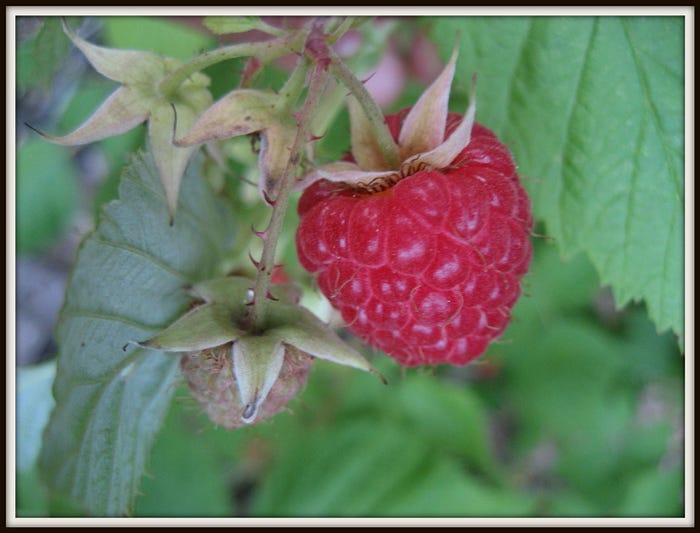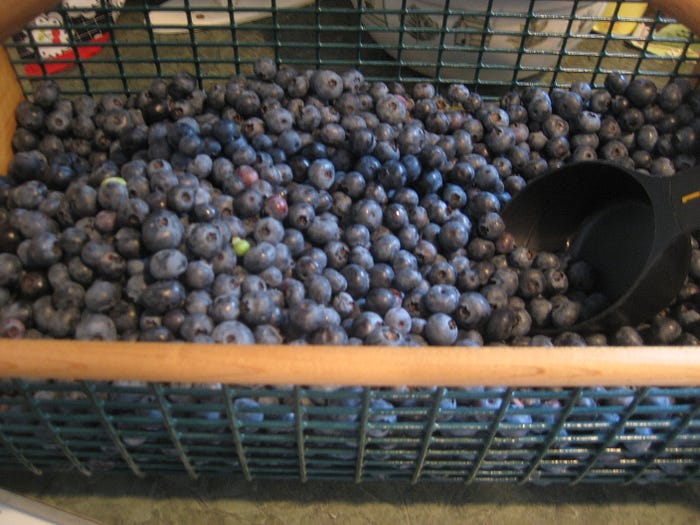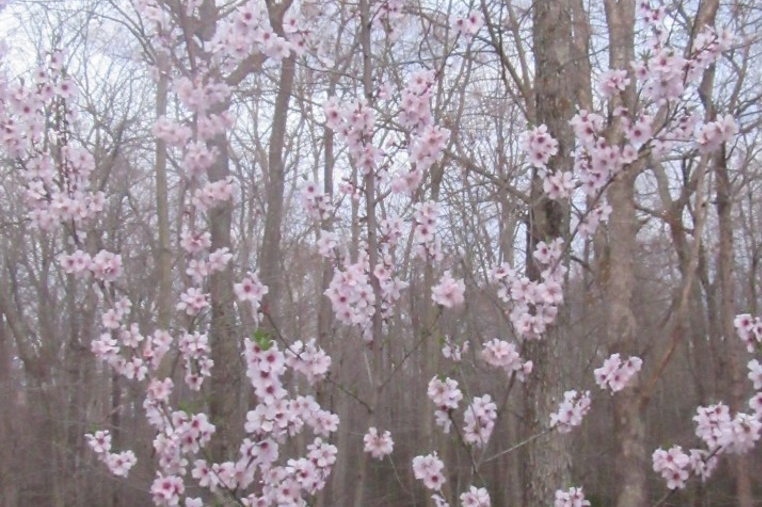Orchards, Berries, and Food Forests
I’ve heard that you plant fruit and nut trees for your children, not yourself, implying that you won’t see them really take off within your lifetime. I take issue with this, because it does NOT take as long as a lifetime for a fruit or nut tree to bear. Though it does take a few years to see a nice harvest, I have had fruit trees give me a little bit of fruit two or three years after planting. It might not be as fast a harvest as from an annual vegetable garden, but it’s still not bad. Nothing in gardening is fast, really, is it? Patience is needed with anything we plant.
So should you plant fruit and/or nut trees? Absolutely, and do it as soon as you can. Trees are extremely generous in their bounty, require very little attention once established, and many things can be made with their fruit. On my little farm, I have 13 fruit trees, one nut tree (an almond), numerous raspberries, blueberries, and blackberries, currants, and grapes. Seven of the fruit trees are in an orchard-like space to one side of the property. All the other trees are tucked into gardens. Berries are tucked into both my fenced vegetable garden and into the perennial gardens in their own little beds, fenced off, but surrounded by plants. Remember, I have heavy deer predation. If I were to leave them unfenced and intermingled with the other plants as I would prefer, I would never get fruit. We have to make do with what we can in the real world!
Things you should know about fruiting trees, berry bushes, vines, and fruiting canes

- Some years are amazing, and you will have more fruit than you know what to do with. Some years are horrible and you’ll get very little. As with anything in gardening, you have to go with the flow and have a backup plan, just in case.
- Both fruit trees and grapevines need to be pruned every year, and you can’t wuss out on it. This lesson took me a long time to learn, and I feel I’m still learning the right way to prune these guys. I learned this lesson with the grapes I grow, as I did not get a decent harvest until I whacked the vines back severely, emulating what I saw in a vineyard. After I did that, they took off, and have been better every year since.
With fruit trees there is a different technique involved, and it needs a little finesse. You need to make the tree look like a wineglass, meaning the branches should come out from the central trunk in a wineglass shape. This opens all the parts of the tree to the sun and air and is better for the tree and the tree will produce better for you. No crossing branches. No sharp Y shapes. No watersprouts. And don’t be a sucker and allow suckers. I prune in the late winter for growth, and in the summer to get rid of things like watersprouts and suckers. Why? Because anything you prune in the winter on any plant is going to come back tenfold and grow like crazy that spring in summer, but anything you prune in the summer is not going to grow back like crazy. So plan accordingly, and prune the parts you need to prune on the tree according to what you’d like it to do for you.
3. I don’t prune my blueberries, except to remove dead branches, of which there have been very few. I have read that I should be pruning them, but since I haven’t seen a problem with not doing it, I’m going to continue not doing it. They also require an acidic soil, which I have been able to provide by saving my coffee grounds and mixing them into the top layer of soil. The rain does the job of getting all the goodness to the rest of the roots for me.
4. Raspberries, blackberries (or cane fruits) should be pruned to prolong their lives. I do this by removing the dead canes early every spring and cutting back the canes when they’ve gone where they shouldn’t. I also thin the cane patch, because they can spring up rather densely, and you really do want sun and air to be able to get to all the parts of the plants you have. I’ve discovered you can be pretty harsh with raspberries, and they don’t seem to mind at all. In fact, sometimes I feel like they think the pruning is a challenge to answer with more growth. They are tough plants.
5. Cane fruits can be trellised, if you like, but it is not necessary for a good harvest. My raspberries are not trellised; rather they grow up and near one side of my vegetable garden’s fence, in a long patch. Others are in beds within gardens, netted for their protection. Other people have created elaborate trellising for their cane fruits. If you do, just know that it needs to be STRONG. Cane fruits are fairly aggressive plants that like to pull things down.
6. Dwarf fruit trees should bear faster than full-sized fruit trees, and if you are short on room, they are a great solution.
7. Be sure that you buy two of any type of fruit tree for pollination, unless they are labeled self-pollinating. Even then, you can’t go wrong with two of them, to increase your chances.
8. Trees are sold in both the early spring and the early fall. I have planted at both times of the year, and haven’t noticed a difference in production or growth from either. I would say that if you see a variety you like, plant it when you see it.
Fruits and Berries in a Food Forest

My version of a food forest
A food forest has layers, which are:
· Overstory
· Understory
· Shrub
· Herbaceous
· Root
· Ground Cover
· Vine
The idea of this comes about because of a simple truth — plants support each other. There is a lot of information out there on food forests, and many different lists of plants that play nicely together and should be grown together (termed guilds). Though different people will have many different opinions, the structure of a food forest follows the list above, and the idea is that all parts of it are edible. I don’t have the luxury of growing edibles all over the place in my yard, due to deer, so I have to modify the food forest to suit. It means that I have edibles within, but many other plants that support them are really just good for pollinators and the soil. There seems to be nothing wrong with this, and I have found that it works very well and the trees seem very happy.
In the picture above you will see a Gala apple on the right, planted underneath with daylilies, spirea, hosta, hardy geraniums, and sedum. (There are daffodil bulbs and hyacinth planted in there as well, but it’s too late in the year in this picture for you to see them.) To the left in the picture you can see a small structure (the black PVC), which is a bed of yellow raspberries. They are netted in, or the deer eat the raspberries, but they still reside within the structure of the garden bed as a whole. This tree and these raspberries have the support of the plants underneath and around them, shading the roots, holding in moisture, creating mulch, and attracting pollinators.
Most of the fruit trees on the property are planted within gardens, such as this one. When I first started, though, I had visions of a beautiful orchard with simply trees in grass, like you would see in a picture, so I planted accordingly. Well, live and learn. Though the trees that I have in an orchard setting do well (they are surrounded by garden beds), I feel that they can do better, so I am replacing the grass directly surrounding the trees with small shrubs like caryopteris and dwarf butterfly bush, herbs like sage and thyme and lemon balm, and self-seeding flowers like calendula and cosmos. In my head it’s an herb-scented meadow. I’ll let you know in a couple of years how it turns out. 🙂
What To Do With ALL That Fruit

Eventually, you have to figure out what to do with your bounty!
Feeding my family comes from several sources here on my little farm — vegetable gardens, dairy and eggs, meat, and fruit. Of all of these things, the fruit trees and berry bushes are the most generous providers for the least amount of input. For example:
· Of the two pear trees on the property, last year I harvested a total of 175 pounds of pears. These are my oldest trees, and therefore the best producers.
· Of the four oldest apple trees on the property, last year I harvested 88 pounds of apples. The trees are about 5 years old, so still young in tree terms.
· Of the three blueberry bushes that produced the most blueberries this year, I harvested 13 pounds of blueberries. I fought a mockingbird family for them, so I’m pretty happy with what I got.
· From the almond tree I have, which is only 6 years old, I got 2 pounds of almonds this year. This should get better the older the tree gets, as nut trees take the longest to mature.
That’s a lot of food. Though I realize you will not live on fruit alone (you can definitely get along better with nuts), they do give you the vitamins you need and make meals a bit more special. A slice of homemade bread with jam? Yes, please. Apples with your pork loin? Sure. And again — they don’t require much input from you, so what have you got to lose? If you are concerned about what to do with all that bounty, other than using it fresh (always amazing), the ways to keep it are (listed easiest to hardest):
· Just put it in a cool cellar. Many apples will keep a long time in a cool cellar, wrapped in paper to keep from touching one another. Go down and grab them when you want them. Make sure you check them from time to time, too. There is truth to the saying that “One bad apple spoils the whole barrel”.
· Freeze it. From slicing it up and freezing the slices, to making pies and freezing them whole for later baking, this is an easy solution to lots of fruit.
· Dry it. Things like pears, cherries, apricots, peaches, etc, don’t keep as well without some sort of processing. If you don’t want to freeze them, dry them. Cut large fruits into slices, halve cherries and put them in a dehydrator. Jar them up and keep them to sprinkle on things like oatmeal or yogurt or to throw into any dish that could use a little sweetness.
· Turn it into fruit leather. Think Fruit Roll-Ups™ for grownups (and kids-don’t actually feed anyone Fruit-Rollups™. Ick) Puree the fruit, thinly spread it on a piece of parchment paper in a dehydrator, and dry it until it’s slightly sticky. Delicious, and great for hiking or kids’ lunches.
· Preserve it in syrup. You’ve seen the cans of suspicious-looking “fruit cocktail” in the supermarkets, I know you have. Do it yourself with one or more fruits, and you can control the amount of sugar you use, depending on whether you make a light or heavy syrup. Can them up in a water bath canner and keep them. They are wonderful additions to meals or for desserts.
· Sauce it. Applesauce is an easy thing to make, only slightly more difficult than preserving your fruits in syrup, because you have to chop up your apples and cook them down for a time. However, the concentration of the fruits’ sugars means you can add less sugar or none. Use a water bath canner to preserve, and you’re good to go. Pear can be processed in the same way.
· Jam it. Upping the difficulty factor here, but this is still not difficult. You can turn your fruit into jams and preserves (they are different things) and can them in a water bath for storage. It takes some time and a little bit of skill, but it’s sooo worth it.
· Chutneys and dipping sauces, baby. Still canning, still cooking, but more than fruit and some sugar, these will require additional ingredients, more time, and more effort. However, they produce foods that will have a sweet/savory flavor that can be used with many different meals. For example, this year I made a Chinese plum sauce for the first time. We like it so much, I have been finding different meals to put it with, which has branched out our boring dinner routine quite a bit. This is the cool thing that happens when you make your own food from your own produce. One afternoon spent making something good-tasting turns into many meals that people enjoy and might not have tried otherwise.
· Butter it. If you’ve ever had apple butter, you probably remember it well. I remember having it for the first time when my family visited Amish country in Pennsylvania when I was young. What a flavor! I put this one further down on the list, not because it’s hard to make — it’s actually just like applesauce in the way that it is prepared — but because it’s really easy to mess up and over or undercook. It’s worth a try if you’re brave, and would be water bath canned, just as a number of the other things listed here. It is awesome on freshly-baked bread.
· Drink it. Ratcheting up in the time-intensity scale and requiring a bit of equipment is fresh cider. Pears and apples make wonderful fresh cider. However, you need a crusher and a press of some sort to make it and a bit of time and muscle power. It’s easy to do, and a great use of A LOT of fruit — as I discovered with those 175 pounds of pears last year. 15–16 pounds makes about a gallon of cider, so you can go through a glut really fast. Compost the leftover pomace, or feed it to your livestock, if you have it. Fresh cider is amazing.
· Get drunk on it (or don’t — drink responsibly!). Hard cidering is an art form using fermentation. It is a lot of fun and fairly easy to do, but it takes a good amount of time and equipment and can come out less than stellar the first few times. I guess you could say it needs a bit of finesse and practice. Just think of it as a learning process, and you’ll be ok. You will need the cider press and crusher, as well as a fermentation kit and some yeast. You also need patience, as it takes a couple of months to mature nicely, but it’s worth it. Imagine popping open a bottle of your hard cider or perry (pear cider) on a special occasion, or just for a nice dinner. What a treat!
Hopefully I’ve convinced you to plant a fruit or nut tree or two in your yard. They can be tucked into a garden, only need pruning twice a year, and they give you pretty flowers, nice fall colors, and lots and lots of food. What a return on your small investment!
See you next time and thanks for reading!
Teaser photo credit: Young almond tree flowering away beautifully in early April.





